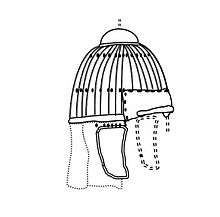Lamellenhelm
The Lamellenhelm (plural Lamellenhelme - German language derived terms) was a type of helmet used in Europe during the Early Middle Ages. Examples are characterized by caps made from overlapping lamellar scales, in addition to a brow plate, cheek guards, and camail. They are distinct from the contemporary spangenhelm and crested helmets also found in Europe; unlike those, which are influenced by Roman designs, Lamellenhelme display eastern influence and have primarily been found in southeastern Europe. They are mostly associated with the Avars of Pannonia and the Lombards of Italy.[1][2]
.jpg)
Description
Lamellenhelme are characterized by overlapping plates—a form of lamellar armour—with caps of conical shape and plumes at the top.[3][4] They also tend to have brow plates, cheek pieces, and, like spangenhelme, camail protecting the neck.[4]

The Lamellenhelm was one of three primary designs of helmets that proliferated throughout 6th- and 7th-century Europe; the others were the spangenhelm and the northern crested helmet.[5] They are categorized by Heiko Steuer with 'other helmets of eastern origin,'[3] and have been principally found in southeastern Europe.[4] Unlike spangenhelme and the northern crested helmets, which likely derive from Roman helmet designs, the Lamellenhelm appears to have been used by and influenced by eastern European cultures, such as the Avars.[3][4]
Lamellenhelme also seem to have been used by the Lombards,[3][4] a Germanic people who ruled most of the Italian Peninsula from 568 to 774. This is suggested both by the discovery of parts of such helmets in Italy, and by the discovery of a brow plate displaying the inscription VICTORIA D[OMINO] N[OSTRO] AGILUL[FO] REGI, ("Victory to our lord, king Agiluf") which names Agilulf, a Lombard king who ruled from 591 to 616.[3][6] The plate also contains a figural scene showing the seated king and, on his left and right, warriors who themselves are wearing comparable plumed helmets.[3] The plate was once part of a helmet that was likely owned by a high-ranking follower of the king.[3]
See also
References
- Tweddle 1992, pp. 1082–1087.
- Steuer 1987, pp. 197–198, 229–230.
- Steuer 1987, p. 197.
- Tweddle 1992, p. 1083.
- Steuer 1987, p. 191.
- Tweddle 1992, pp. 1083, 1085.
Bibliography
- Steuer, Heiko (1987). "Helm und Ringschwert: Prunkbewaffnung und Rangabzeichen germanischer Krieger". In Häßler, Hans-Jürgen (ed.). Studien zur Sachsenforschung. 6. Hildesheim: Lax. pp. 189–236. ISBN 3-7848-1617-7.CS1 maint: ref=harv (link) (in German)

- Tweddle, Dominic (1992). The Anglian Helmet from 16–22 Coppergate (PDF). The Archaeology of York. 17/8. London: Council for British Archaeology. ISBN 1-872414-19-2. Archived from the original (PDF) on 25 February 2017.CS1 maint: ref=harv (link)
